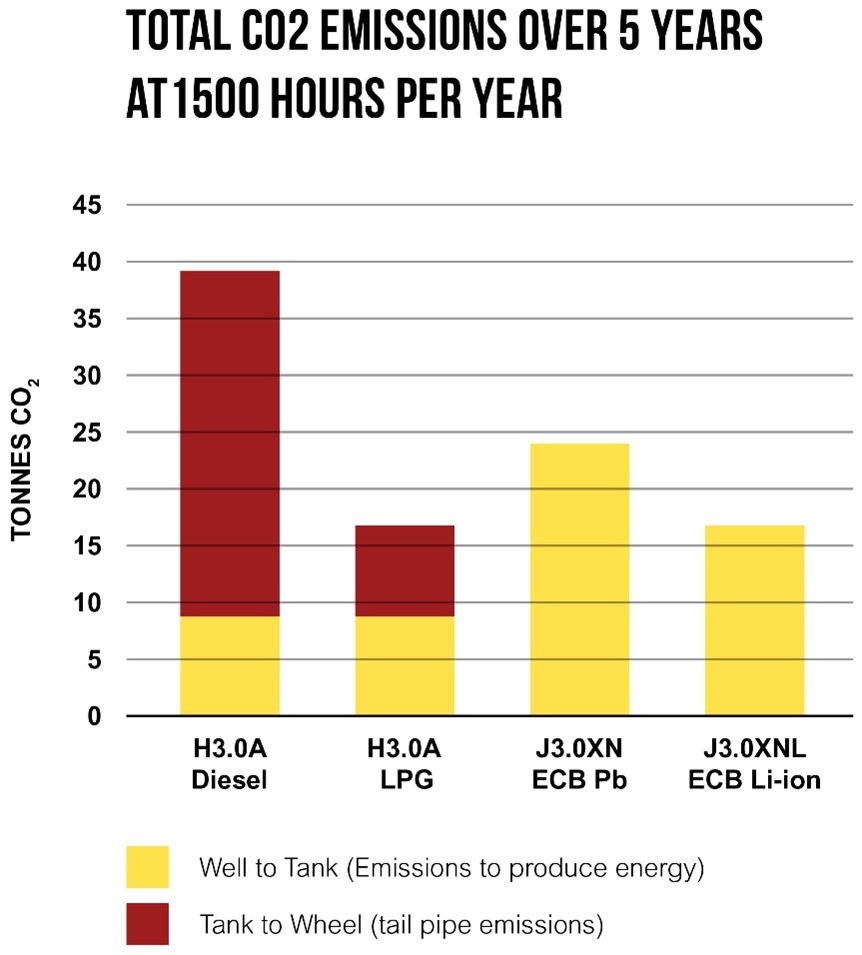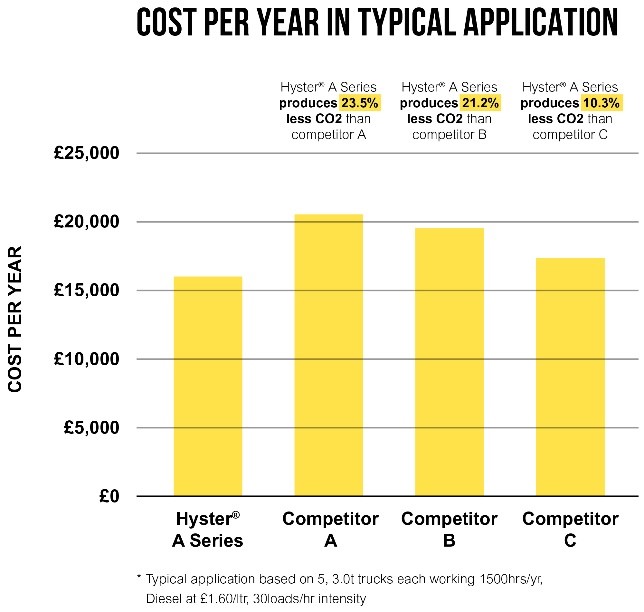Minimising emissions across a fleet can be challenging, especially as ICE counterbalance lift trucks still make up a significant percentage of the market in Europe. Most warehouse equipment is already electric, and many different electric forklifts, with zero tailpipe emissions, are already available. From Hyster alone, these are available at capacities from 1.3 tonnes, up to 18 tonnes. Yet businesses are often waiting for the right time to make the switch, keen to move to electrics when they are sure they can do so and maintain the productivity needed and minimise the Total Cost of Ownership (TCO).
The right choice of lift truck will always depend on the specific application. In some instances, moving to electric trucks to help reduce emissions will be feasible. Many electric trucks can provide ICE-like performance, and additional productivity benefits due to faster acceleration times. Yet other applications may struggle to find a comparable electric model that delivers on factors like ground clearance, manoeuvrability, and robustness in outdoor use. Cab space may also be compromised on some electric trucks that feature a large battery compartment, so operator comfort is also a consideration.
Infrastructure goes electric
There are also infrastructure considerations when moving from ICE to electric forklifts. Operations using ICE lift trucks may be used to quickly and easily refuel their trucks only every couple of days. With electric trucks, they would need to ensure their site features weatherproof charging and/or battery exchange areas and that they have the equipment to move batteries, chargers, and cables. Also, that there is storage for spare batteries.
Applications which may be charging multiple batteries at once will also need to consider the related power consumption. Even when opportunity charging highly efficient lithium-ion batteries, on breaks for example, this can pull high currents. Developing the infrastructure to support charging may require additional investment, so replacing ICE fleets with electric trucks to reduce direct emissions requires careful analysis of the application and its requirements. Involving your equipment supplier or dealer early on can help with this.
Many will find that the overall, long-term costs relating to electric lift trucks make them a sound investment. They may deliver both a reduction in cost and direct emissions. However, in some instances the right technology for the application may currently be ICE lift trucks. So where does this leave these businesses when it comes to reducing emissions?
Lift truck power source choice is a balance
Understanding indirect emissions is also important. There are three internationally recognised scopes for classifying emissions.
- Scope 1 covers direct emissions from owned or controlled sources
- Scope 2 covers indirect emissions from the generation of purchased electricity, steam, heating, and cooling. This is where “wheel to wheel” emissions are covered
- Scope 3 includes all other indirect emissions that occur in a company’s value chain
Switching from ICE forklifts to those powered by batteries clearly reduces Scope 1 direct emissions, as tailpipe emissions are eliminated. However, this does not always reduce Scope 2 emissions. If the aim is to reduce total emissions, both of these elements should be considered as part of selecting the right fleet and its environmental impact.
Analysing indirect emissions is not yet an exact science. For instance, using electricity generated from burning coal has a very different environmental impact from renewable electricity. The same is true with diesel and biodiesel. And the energy supply for different sites across a business may also vary, making this calculation more difficult.
However, in some cases, when you consider the emissions required to produce the energy, LPG forklifts may have a lower indirect emissions impact than electric trucks (both lead acid and lithium-ion batteries).
Comparing ICE and electric forklift emissions
The following chart shows an example of the emissions of a 3-tonne counterbalance lift truck, used for 1500 hours per year in a medium duty application, using European averages for CO2 levels for each fuel type. Here we compare an electric Hyster® J3.0XN with lead acid battery, a Hyster J3.0XNL with lithium-ion battery, and IC trucks from the new Hyster A Series, the H3.0A fuelled with diesel and LPG.

You can clearly see that direct emissions are zero for both of the electric models. However, to get an idea of the overall emissions for the truck, this chart also shows the emissions required to produce the energy. You will see that the IC lift trucks in this example actually have lower indirect emissions impact than the electric trucks.
If a business has determined that IC lift trucks are still the best match for the application, there is still scope to reduce emissions by addressing the indirect emissions of their lift truck fleet. Not all trucks are equal when it comes to “well to wheel” emissions.
For instance, the new Hyster A Series lift trucks are designed to be highly fuel efficient. In fact, these forklifts are more than 13% more efficient than leading competitors*, helping reduce fuel costs by thousands of pounds per year. In terms of emissions, this performance means that Hyster A Series lift trucks may also produce up to 23.5% less CO2 per year than leading competitors.


What about Scope 3?
The final area for businesses to consider around overall emissions is the CO2 impact of the production of the forklift itself, so it is important to partner with manufacturers that help support this. For example, Hyster has been working hard to optimise emissions levels at all its plants, with green manufacturing initiatives and innovative design to reduce emissions and optimise energy efficiency. Plus, a typical Hyster truck is more than 95% recyclable (by weight)**.
What is clear is that materials handling equipment is a key area where businesses can make an impact on emissions, and many will eventually switch to electric power for zero direct emissions. However, in the interim, businesses can still reduce overall emissions by considering the indirect emissions of every forklift they add to their fleet.
For more guidance, visit www.hyster.com or speak to your Hyster® dealer.
* According to standard test EN 16796, which is set out by the VDI. This compares all values of fuel consumption that have been published by each of the following European based manufacturers. (Linde, STILL, Jungheinrich, Toyota, Nissan, Komatsu). If the manufacturer is not on the list, then it is not stated in their spec sheets.
** Figure estimated by Hyster-Yale Group based on typical 2.5t class V counterbalance truck, excluding fluids.


